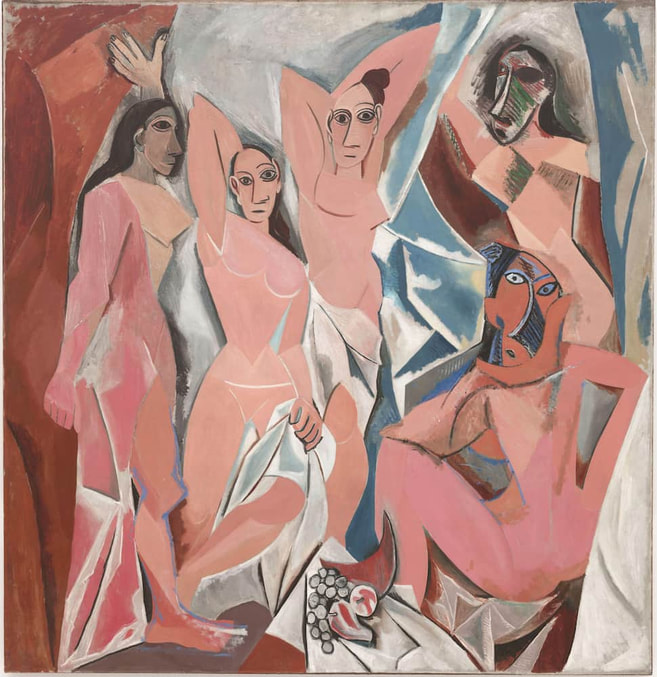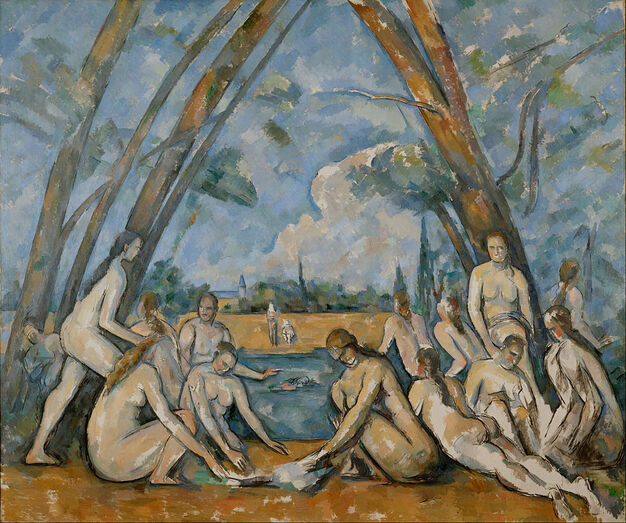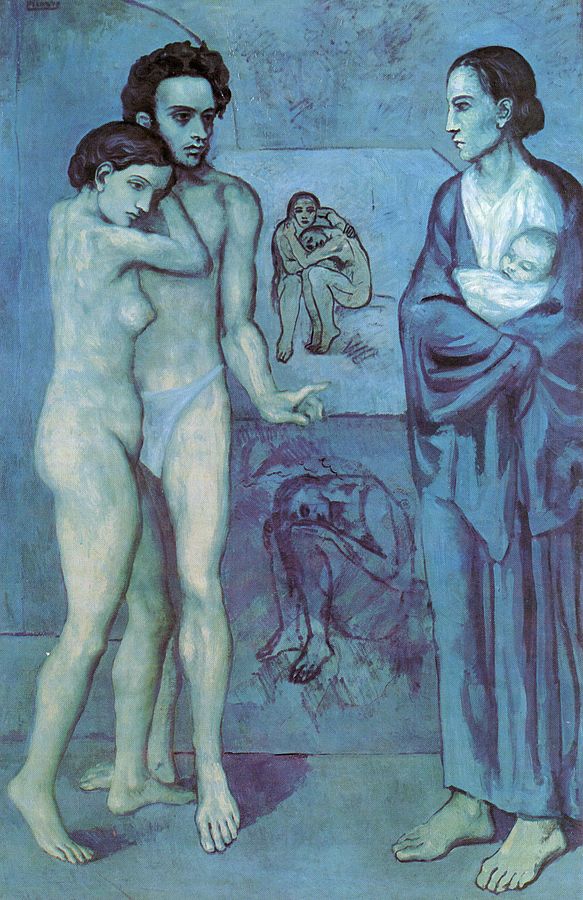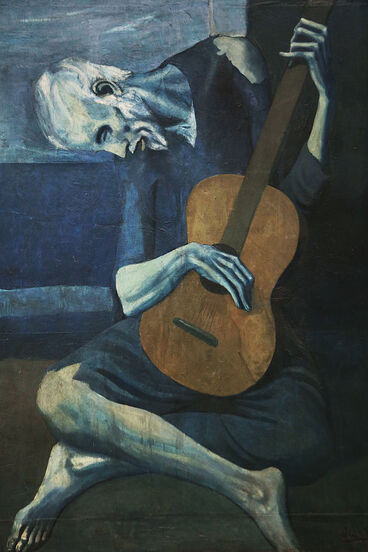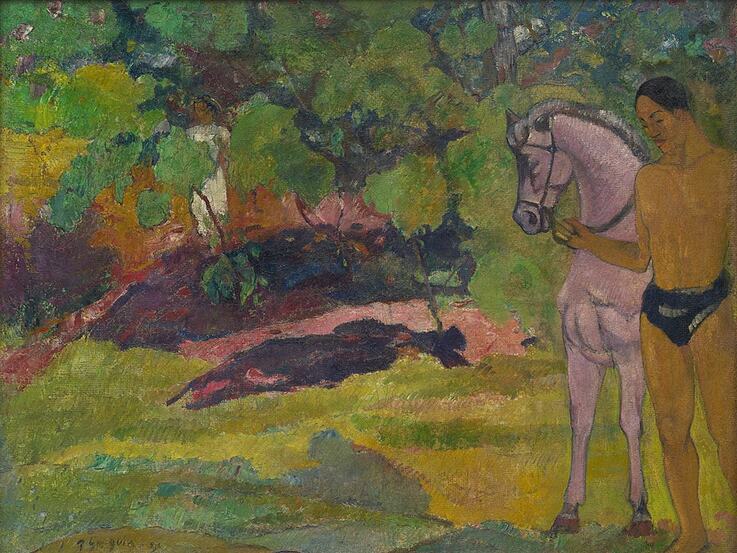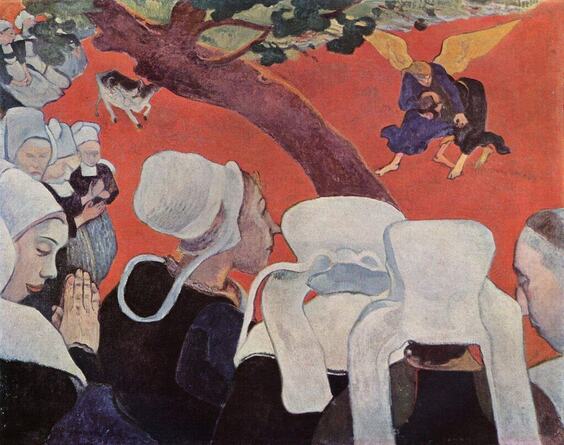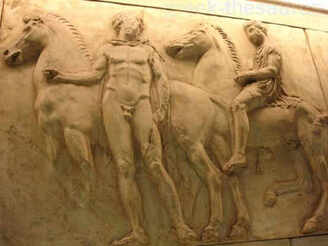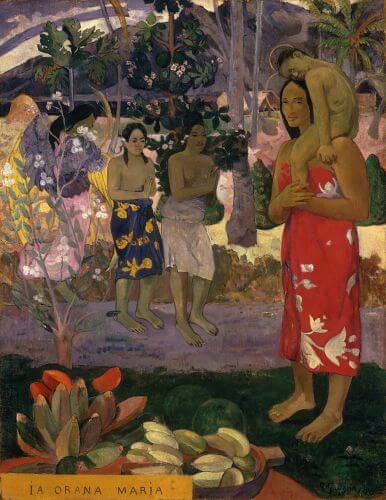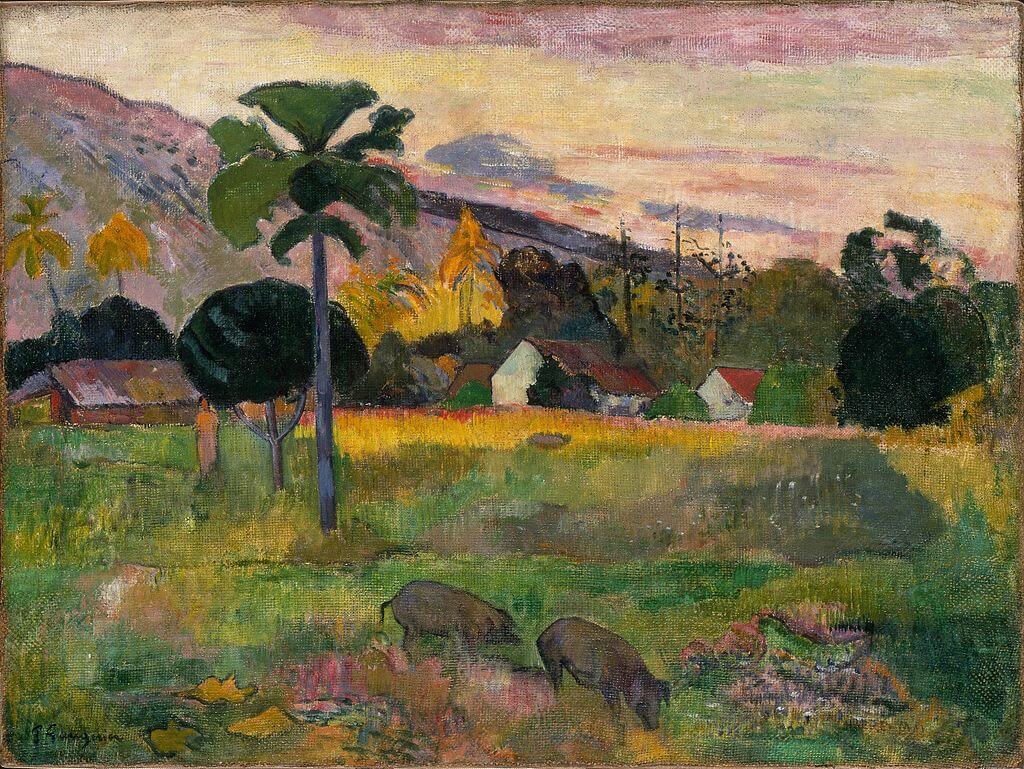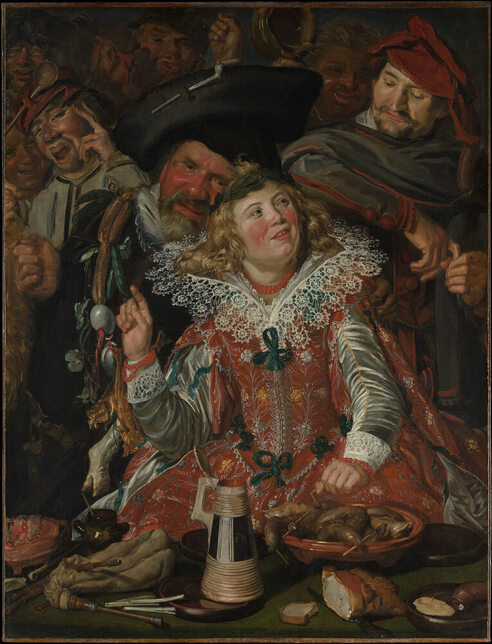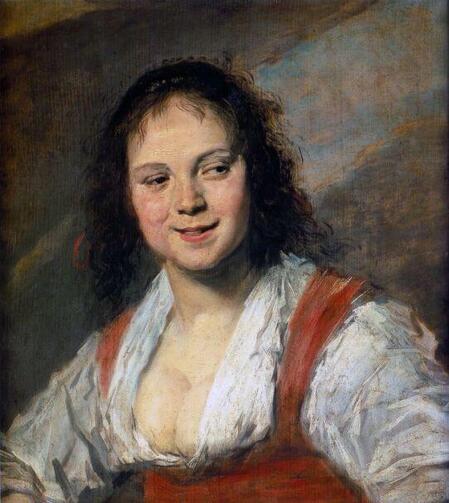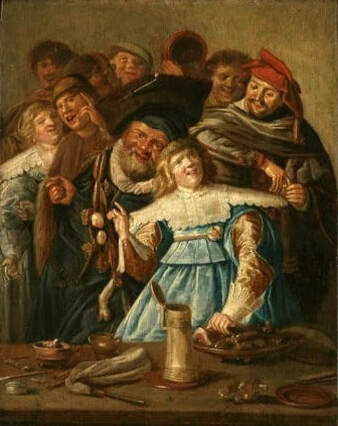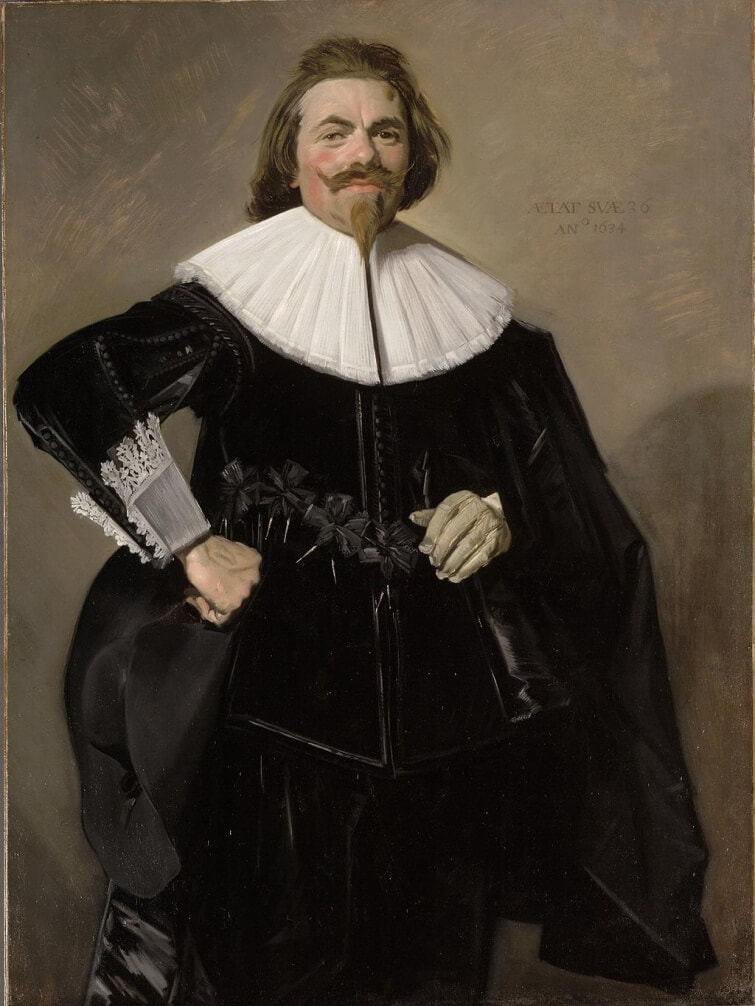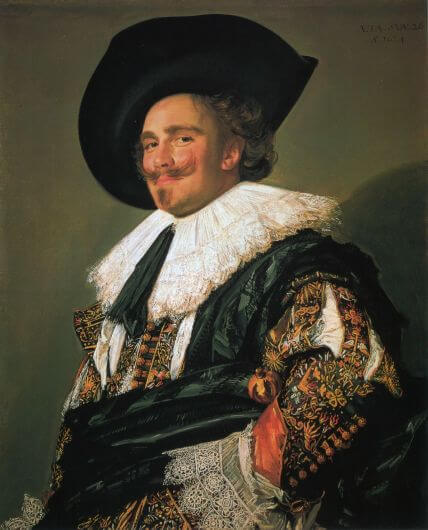|
Where? Floor 5, Gallery 2 of the Museum of Modern Art
When? 1907 What do you see? Five nude women in a brothel. The women are not interacting with each other. The woman on the left holds back a curtain to show the other women. The woman to her right and the woman in the middle are looking boldly at the viewer while exposing their bodies. It is unclear whether they are standing or laying down. Look, for example, at the second woman from the left. Her legs are partly crossed, she has a sheet between her legs and her arm behind her head. The woman in the middle and the two women to her left have relatively normal faces. The two women on the right wear African masks. During the time that Picasso created this painting, he was interested in African artifacts, such as African tribal masks. The woman on the bottom right has her head turned around 180 degrees to look at the viewer, while the standing woman on the right appears from behind a curtain. Picasso uses a lot of angular shapes, like triangles and diamonds, in this painting, to simplify the painting and make it quite abstract. In the foreground is a table in an impossible position to hold the bowl of fruit. In the bowl, we can recognize an apple, a pear, grapes, and a pink slice of melon. Backstory: The French title of this painting is translated as ‘The Young Women of Avignon.’ Avignon refers to a notorious street in the red light district of Barcelona, Spain. Picasso was familiar with this area as he frequented it while skipping school as a teenager and he had also lived nearby it. Picasso, however, disliked the title of this painting which was given by his friend André Salmon for an exposition in 1916 of which the painting was a part of. Picasso preferred the title ‘Mon Bordel’ which means ‘My Brothel’ or ‘Le Bordel d’Avignon’ which means ‘The Brothel of Avignon.’ Fellow artists and friends were initially shocked by this painting as the women in this painting were so ugly. Nowadays, this painting is considered to be one of the most revolutionary paintings of the 20th century, and it is one of the works that marks the beginning of Modern Art. One of the closest, earlier works related to this painting is The Large Bathers by Paul Cézanne in the Philadelphia Museum of Art, created between 1898 and 1905. This is a painting that Picasso had seen shortly before finishing Les Demoiselles d’Avignon. In 1939, the Museum of Modern Art completed a $24,000 transaction to acquire this painting.
What is Cubism? The idea behind cubism is that all forms in nature can be reduced to three solids: cube, sphere, and cone. This reduction was an idea of Paul Cézanne. Basically, the objects in a painting are analyzed, divided into pieces, and then painted in a more abstract form. Thus, realistic details like perspective and color are omitted and replaced by the three solids proposed by Cézanne.
There are different stages of cubism.
Who is Picasso? Pablo Picasso (1881-1973) was born in Malaga, Spain. In his teenage years, he moved to Barcelona, but most of his adult life he lived in France. He was an artistic talent and has created many paintings, sculptures, and poems. Picasso was an innovative artist who developed a large number of art styles. Every few years he drastically changed his art style. For example, between 1901 and 1904, he was in his Blue Period. Two great examples from that period are La Vie which is at the Cleveland Museum of Art and Old Guitarist which is at the Art Institute of Chicago. Between 1904 and 1906 was his Rose Period. In the decade after his Rose Period, he developed various forms of cubism. Together with Georges Braque, Picasso pioneered the Cubist art movement, inspired by artists such as Cézanne, Gauguin, and Toulouse-Lautrec.
Fun fact: Based on sketches by Picasso, we know that he initially planned to include two additional figures in this painting (see one of those sketches here).
0 Comments
Where? Part of the Thannhauser collection of the Solomon R. Guggenheim Museum
When? 1891 What do you see? This painting is situated in a small forest in Tahiti used to grow vanilla. The vanilla vines climb up the trees. The majority of the painting is made up by the landscape. In the bottom half of the painting, Gauguin used abstract color areas to depict the grassland. The forest in the background looks more like a tapestry. In the right foreground, a man holding his horse can be seen. The man is only wearing black shorts. He is looking down while waiting and does not have much expression on his face. In between the trees, just left to the middle, a woman dressed in white hides in the forest. It seems that the two people have arranged a romantic meeting (a rendezvous) between them that needs to remain a secret.
Synthetism: This is an artistic style used by artists such as Gauguin and Émile Bernard. It is a combination of different approaches to painting. For example, on the one hand, the real world can be depicted in a painting, while, on the other hand, the artist’s dream world can also be depicted.
As Gauguin was an artist who mainly painted from his imagination, he combined the real world which he saw in front of him with the ideas that he had in his mind. In this painting, he combined the landscape in French Polynesia with a scene in his mind from a man with a horse that was inspired by one of the friezes of the Parthenon. An even better example of this style is the painting Vision after a Sermon by Gauguin. In this painting, several women are leaving the church at the bottom, and they see a vision of Jacob wrestling with the Angel, which was the subject of the sermon.
Who is Gauguin? Eugène Henri Paul Gauguin (1848-1903) was born in Paris. He was a Post-Impressionist painter. He is known for his experimental use of different colors, which has had a big impact on future artists such as Picasso and Matisse.
On April 1, 1891, Gauguin left to Tahiti, which is the largest island of French Polynesia and lies in the middle of the Pacific Ocean. His idea was to escape from the artificial life in France and to immerse in nature, live like a child would do, and focus on his art. The first painting he created on Tahiti is Hail Mary which is now on display in the Metropolitan Museum of Art. At the same time as the painting In the Vanilla Grove, Man and Horse, he also painted Haere Mai, which is also on display at the Guggenheim Museum. Gauguin stayed in Tahiti for two years, before returning to France in August 1893. In 1895, he returned to French Polynesia where he stayed until his death. During his life, Gauguin was often struggling for enough money to be a full-time painter, but his work became very popular after his death.
Tahiti: Tahiti is an island in the middle of the Pacific Ocean. It is formed by volcanic activity and is a part of France. 70% of the total population (which is less than 200,000) consists of indigenous Tahitians. While many people speak the Tahitian language, French is the official language. The island contains a small airport but has direct flights to Los Angeles, Paris, Sydney, and Tokyo. Vanilla is one of the important export products of Tahiti. The island contains a small museum dedicated to Gauguin, appropriately called the Paul Gauguin Museum.
Fun fact: In 1893, Gauguin returned to Paris to sell some of his paintings. During his time there he dressed in traditional Polynesian cloths and started an affair with an exotic teenager. His stay in France was not a success, and his ideas and his reputation were verbally attacked in the Mercure de France magazine by several contemporaries. Disappointed, he returned in 1895 to French Polynesia, where he could focus again on his art without much distraction from the artificial and conventional aspects of life.
Written by Eelco Kappe
Where? Gallery 630 of the Metropolitan Museum of Art
When? 1616 Commissioned by? Unknown. Possibly a chamber of rhetoric or it was uncommissioned. What do you see? In the center, a woman dressed in a colorful and carnivalesque embroidered costume raises her right hand. She wears a wreath of laurel on her head and red beads around her neck and arms. Next to her are two comical characters. Six other characters surround the three central figures. Frans Hals painted these surrounding people very loosely. The people celebrate Shrovetide, a kind of Mardi Gras or carnival, in the days before Lent starts. To the left of the woman (from our point of view) is an older man grabbing her shoulder. He tries to say something to her. This man is called Peeckelhaering (which means pickled herring), and he can be recognized by two herrings hanging on a cord around his neck (see the two herrings next to the lower arm of the woman). Other items hanging on this cord are sausages, beans, a mussel, broken eggs, and a pig foot. In his right hand, he holds a foxtail. On the right is a man with a red cap looking at the woman in the center. He makes a sexual gesture with his hands. The table in the foreground contains various items, including a bowl with fish, an open can, half a loaf of bread, and deflated bagpipes. Backstory: This painting is also known as “Shrovetide Revellers.” Frans Hals probably depicts a play performed for Carnival. All actors in this play were men, and so the woman in the center is probably a man dressed up as a woman. She wears a wig and makeup. However, her hands are smaller than the hands of the men next to her. This feature either indicates that the man was built in a way that made it easy for him to dress up like a woman, or that she is a woman after all. Hals got inspiration for this painting from the works of Flemish artists like Rubens, Jordaens, and Jan Brueghel the Elder. He had seen their works earlier in 1616 during his 3-month visit to Antwerp. He took the modern Flemish ideas of a very busy composition and colorful figures and applied these to this painting. Hals painted the figures in the background using broad and loose brush strokes. Hals illustrates his trademark brushstrokes perfectly in the painting The Gypsy Girl in the Louvre, which he painted between 1626 and 1628. In 1907, Merrymakers at Shrovetide was bought for 89 thousand dollars by the American art collector Benjamin Altman. He left it for the Metropolitan Museum of Art after his death in 1913.
Symbolism: The two characters next to the woman in the center are two comical characters that played roles in the Baroque theater during that day. The man on the left (from our point of view) is Peeckelhaering. In his right hand, he has a foxtail, the symbol of a fool. A string with items hangs around his neck.
The man on the right is Hans Wurst. He makes an obscene gesture with his hands to the woman. Some of the items on the table are also sexual references. For example, the deflated bagpipes are another reference to the limited sexual potential of Peeckelhaering. What is Shrovetide? The Christian period of preparation for the six-week Lent. This period is strongly associated with Carnival. Shrovetide begins on the Septuagesima Sunday, the ninth Sunday before Easter. It lasts for 2.5 weeks and ends on Shrove Tuesday. The day after Shrove Tuesday is Ash Wednesday, the first day of Lent. Shrove Tuesday is a day with two different faces. Some people use this day to self-reflect and figure out what sins they regret and how they can grow spiritually. Other people celebrate this day wildly, as it is the last day on which they can indulge in food and drinks.
Who is Hals? Frans Hals the Elder was a Baroque painter. He was born in Antwerp, Belgium, by the end of 1582 (or early 1583). At a young age, his family moved to Haarlem, The Netherlands, where Frans would spend the rest of his life.
During the year that Hals painted Merrymakers at Shrovetide, he also became a member of a local chamber of rhetoric called ‘De Wyngaertrancken’ (the vine tendrils). He did not participate in the performances of this chamber of rhetoric as he was a “second member,” which means that he merely admired the performances of other members. It shows his interests in depicting these plays even though his real specialty were the portraits that he painted. Among his most famous portraits are the Portrait of Tieleman Roosterman in the Cleveland Museum of Art and The Laughing Cavalier in the Wallace Collection in London.
Fun fact: Hans Wurst, the man on the right of the woman (from our point of view), was a comical character in 17th-century performances. Hans Wurst means John Sausage, and he can be recognized by the sausage dangling from his cap. He waved this sausage in front of his fellow players to make fun of them. Hans Wurst makes an obscene gesture. He puts the thumb of his left hand in between the middle and ring finger of his right hand, which form a circle. This is a gesture suggesting to penetrate the woman.
Interestingly, this gesture was not visible in the painting when the Metropolitan Museum of Art received it in 1913. Only after they cleaned the painting, the gesture became visible. During this cleaning in 1951, the six figures in the background were also discovered. Interested in a copy for yourself? Poster |
Categories
All
|
- Home
- Blog
-
Museums
- Alte Pinakothek
- Art Institute of Chicago
- Baltimore Museum of Art
- Barber Institute of Fine Arts
- Bargello
- Barnes Foundation
- British Museum
- Church of Sant’Anastasia
- Cleveland Museum of Art
- Courtauld Institute of Art
- Detroit Institute of Arts
- Frans Hals Museum
- Galleria Borghese
- Gallerie dell'Accademia
- Getty Museum
- Guggenheim
- Hermitage Museum
- Kunsthistorisches Museum
- Kunstmuseum Basel
- Legion of Honor Museum
- Louvre
- Mauritshuis
- Metropolitan Museum of Art
- Musee d’Orsay
- Museum of Fine Arts in Boston
- Museum of Modern Art
- National Gallery in London
- National Gallery of Art
- National Museum in Poznań
- Norton Simon Museum
- Ny Carlsberg Glyptotek
- Palace of Versailles
- Palazzo Pitti
- Palazzo Vecchio
- Petit Palais
- Philadelphia Museum of Art
- Prado
- Pushkin Museum
- Ravenna Art Museum
- Rijksmuseum
- San Diego Museum of Art
- Santa Maria delle Grazie
- St. Peter's Basilica
- Städel Museum
- Statens Museum for Kunst
- Tate Britain
- Tate Modern
- Timken Museum of Art
- Uffizi
- Vatican Museums
- Wallace Collection
-
Artists
- Altdorfer
- Anguissola
- Berlin Painter
- Bosch
- Botticelli
- Boucher
- Bronzino
- Bruegel the Elder
- Brunelleschi
- Cabanel
- Caillebotte
- Canova
- Caravaggio
- Carpeaux
- Cezanne
- Cimabue
- David
- Degas
- Delacroix
- De Maria
- Donatello
- El Greco
- Fontana
- Fra Angelico
- Fragonard
- Gauguin
- Gentileschi
- Gericault
- Gonzalez-Torres
- Goya
- Hals
- Hogarth
- Hokusai
- Ingres
- Leonardo da Vinci
- Lippi, Filippo
- Longhi, Barbara
- Lorrain
- Makovsky
- Manet
- Massys
- Matisse
- Merian
- Michelangelo
- Mochi
- Modigliani
- Monet
- Panini
- Parmigianino
- Perugino
- Picasso
- Pisanello
- Raphael
- Rembrandt
- Renoir
- Reynolds
- Rivera
- Rodin
- Rubens
- Scultori
- Seurat
- Steen
- Tintoretto
- Titian
- Toulouse-Lautrec
- Turner
- Uccello
- Van der Weyden
- Van Dyck
- Van Eyck
- Van Gogh
- Van Hemessen
- Vasari
- Velazquez
- Vermeer
- Veronese
- Vigée Le Brun
-
Locations
- Books
- About Us

